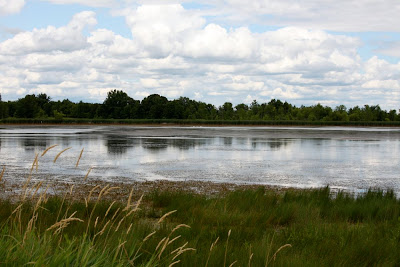 American Dream
American DreamWe have lost much of what was America—
the prominent tallgrass prairies of our Midwest, the natural look of this land.
 Purple Coneflower, Echinacea purpurea
Purple Coneflower, Echinacea purpureaWhere, within open spaces dominated by the towering seedheads of big bluestem, Indiangrass and switchgrass, wildflowers on leggy stems emerged from between the broad, toothed leaves of prairie dock. Fields were sprinkled with shades of lavender in spreading stands of wild bergamot. Blankets of purple coneflower, rested beneath reaching rods of blazingstar.
And a lovely, wild lily was found here--
head nodding from a tall, slender stem.
 Sullivant's Milkweed, Asclepias sullivantii
Sullivant's Milkweed, Asclepias sullivantii
 Wild Burgamot, Monarda fistulosa
Wild Burgamot, Monarda fistulosa Michigan Lily, Lilium michiganense
Michigan Lily, Lilium michiganenseOnto fertile, black earth, the steel plow arrived, to turn and till these plains—
plant crops for a growing nation.
Until today, only fragments remain.
Of those hardy prairie plants, tough enough to withstand the droughts claiming others less well-rooted, the fires necessary for their survival.
Once covering more than a million acres, the wild beauties of Ohio’s Tallgrass have become a sight you, now, must search to see.
 Trumpeter Swans and cygnets on lake
Trumpeter Swans and cygnets on lake

Past a small, yellow farmhouse and its neighboring cell tower straddling dense, deep rows of green corn, is Killdeer Plains, a remnant of the Sandusky Plains Prairie of long ago.
Its gravel roads and gated paths signify its place now—
a space set aside from the others.
Tucked between fields of winter wheat,
preserved and protected from change.
 Purple Coneflower and Blazingstar, Liatris sp.
Purple Coneflower and Blazingstar, Liatris sp.
From across this wide sky, where clouds are stacked upon the horizon waiting for the full light of day, an eagle crosses before me. And takes his place in the dead tree on this prairie which now is his home.
If we could do things differently, would we--
redefine the American dream?
 Bald Eagle over Killdeer Plains
Bald Eagle over Killdeer Plains
View more ABC Wednesdays here!


















































































%20copy.jpg)


















